Askeland D.R., Fulay P.P. Essentials of Materials Science & Engineering
Подождите немного. Документ загружается.


TABLE 15-1 9 Functional classification of ceramics*
Function Application Examples of Ceramics
Electrical Capacitor dielectrics BaTiO
3
, SrTiO
3
,Ta
2
O
5
Microwave dielectrics Ba(Mg
1=3
Ta
2=3
)O
3
, Ba(Zn
1=3
Ta
2=3
)O
3
BaTi
4
O
9
,Ba
2
Ti
9
O
20
,Zr
x
Sn
1x
TiO
4
,Al
2
O
3
Conductive oxides In-doped SnO
2
(ITO)
Superconductors YBa
2
Cu
3
O
7x
(YBCO)
Electronic packaging Al
2
O
3
Insulators Porcelain
Solid-oxide fuel cells ZrO
2
, LaCrO
3
, LaMnO
3
Piezoelectric Pb(Zr
x
Ti
1x
)O
3
(PZT ), Pb(Mg
1=3
Nb
2=3
)O
3
(PMN)
Electro-optical PLZT, LiNbO
3
Magnetic Recording media g-Fe
2
O
3
, CrO
2
(‘‘chrome’’ cassettes)
Ferrofluids, credit cards Fe
3
O
4
Circulators, isolators, Nickel zinc ferrite
Inductors, magnets Manganese zinc ferrite
Optical Fiber optics Doped SiO
2
Glasses SiO
2
based
Lasers Al
2
O
3
, yttrium aluminum garnate (YAG)
Lighting Al
2
O
3
, glasses.
Automotive Oxygen sensors, fuel cells ZrO
2
Catalyst support Cordierite
Spark plugs Al
2
O
3
Tires SiO
2
Windshields/windows SiO
2
based glasses
Mechanical/Structural Cutting tools WC-Co cermets
Sialon
Al
2
O
3
Composites SiC, Al
2
O
3
, silica glass fibers
Abrasives SiC, Al
2
O
3
, diamond, BN, ZrSiO
4
Biomedical Implants Hydroxyapatite
Dentistry Porcelain, Al
2
O
3
Ultrasound imaging PZT
Construction Buildings Concrete
Glass
Sanitaryware
Others Defense applications PZT,B
4
C
Armor materials
Sensors SnO
2
Nuclear UO
2
Glasses for waste disposal
Metals processing Alumina and silica-based refractories, oxygen sensors,
casting molds, etc.
Chemical Catalysis Various oxides (Al
2
O
3
, ZrO
2
, ZnO, TiO
2
)
Air, liquid filtration
Sensors
Paints, rubber
Domestic Tiles, sanitaryware,
Whiteware, kitchenware,
Pottery, art, jewelry
Clay, alumina, and silica-based ceramics, glass-ceramics,
diamond, ruby, cubic zirconia and other crystals
* Acronyms are indicated in italics.
CHAPTER 15 Ceramic Materials470

carbon-carbon composites, and other ceramics to provide protection at these extreme
temperatures. SiC is also used as an abrasive in grinding wheels and as particulate and
fibrous reinforcement in both metal matrix and ceramic matrix composites. It is also
used to make heating elements for furnaces. SiC is a semiconductor and is a very good
candidate for high-temperature electronics.
9
Silicon nitride (Si
3
N
4
) has properties similar to those of SiC, although its oxida-
tion resistance and high-temperature strength are somewhat lower. Both silicon nitride
and silicon carbide are likely candidates for components for automotive and gas turbine
engines, permitting higher operating temperatures and better fuel e‰ciencies with less
weight than traditional metals and alloys.
9
Titanium Dioxide (TiO
2
) is used to make electronic ceramics such as BaTiO
3
.
The largest use, though, is as a white pigment to make paints. Titania is used in certain
glass ceramics as a nucleating agent. Fine particles of TiO
2
are used to make suntan
lotions that provide protection against ultraviolet rays.
9
Zirconia (ZrO
2
) is used to make many other ceramics such as zircon. Zirconia
is also used to make oxygen gas sensors that are used in automotives and to measure
dissolved oxygen in molten steels. Zirconia is used as an additive in many electronic
ceramics as well as a refractory material. The cubic form of zirconia single crystals is
used to make jewelry items. Fuel cells based on zirconia will likely appear in cars by the
year 2015.
15-2 Properties of Ceramics
The prope rties of some ceramics are summarized in Table 15-2. Mechanical properties
of some structural ceramics are summarized in Table 15-3.
Take note of the high-melting temperatures and high-compressive strengths of
ceramics. We should also remember that the tensile and flexural strength values show
considerable variation since the strength of ceramics is dependent on the distribution of
flaw sizes and is not a¤ected by dislocation motion. We discussed the Weibull dis-
tribution and the strength of ceramics and glasses in Chapter 7. Also note that, contrary
to common belief, ceram ics are not always brittle. Under smaller strain rates and at
high temperatures, many ceramics with a very fine grain size indeed show superplastic
behavior.
TABLE 15-2 9 Properties of commonly encountered polycrystalline ceramics
Material Melting Point (
˚
C)
Thermal Expansion Coefficient
(D10
6
cm/cm)/
˚
C
Knoop Hardness (HK)
(100 g)
Al
2
O
3
2000 @6.8 2100
BN 2732 0.57
a
, 0.46
b
5000
SiC 2700 @3.7 2500
Diamond 1.02 7000
Mullite 1810 4.5 —
TiO
2
1840 8.8 —
Cubic ZrO
2
2700 10.5 —
a
Perpendicular to pressing direction.
b
Parallel to pressing direction.
15-2 Properties of Ceramics 471

15-3 Synthesis and Processing of Ceramic Powders
Ceramic materials melt at high temperatures and they usually exhibit a brittle behavior
under tension. As a result, the casting and thermomechanical processing, used widely
for metals, alloys, and thermoplastics, cannot be applied when processing ceramics.
Inorganic glasses, though, make use of lower melting temperatures due to the formation
of eutectics and are made using the float-glass process. Since melting, casting, and
thermomechanical processing is not a viable option for polycrystalline ceramics, we
typically process ceramics into useful shapes starting with ceramic powders. A powder is
a collection of fine particles. The step of making a ceramic powder is defined here as the
synthesis of ceramics. We begin with a ceramic powder and get it ready for shaping by
crushing, grinding, separating impuritie s, blending di¤erent powders, and spray drying
to form soft agglomerates. Di¤erent techniques such as compaction, tape casting, ex-
trusion, and slip casting are then used to convert properly processed powders into a
desired shape to form what is known as a green ceramic. A green ceramic is a ceramic
that has not yet been sintered. The steps of converting a ceramic powder (or mixture of
powders) into a useful shape are known as powder processing. The green ceramic is then
consolidated further using a high-temperature treatment known as sintering or firing. In
this process, the green ceramic is heated to a high temperature, using a controlled heat
treatment and atmosphere, so that a dense material is obtained. The ceramic may be
then subjected to additional operations such as grinding, polishing, or machining as
needed for the final application. In some cases, leads will be attached, electrodes will be
deposited, or coatings may have to be deposited. These general steps encountered in the
synthesis and processing of ceramics are summarized in Figure 15-1.
Ceramic powders prepared using conventional or chemical techniques are shaped
using the techniques shown in Figure 15-2. We emphasize that very similar processes
are used for processing metal and alloy powders, a route known as powder metallurgy.
Powders consist of particles that are loosely bonded, and powder processing involves
the consolidation of these powders into a desired shape. Often, the ceramic powders
prepared need to be converted into soft agglomerates by spraying a slurry of the pow-
der through a nozzle into a chamber (spray dryer) in the presence of hot air. This
process leads to the formation of soft agglomerates that flow into the dies used for
powder compaction; this is known as spray drying.
TABLE 15-3 9 Mechanical properties of selected advanced ceramics
Material
Density
(g/cm
3
)
Tensile
Strength
(MPa)
Flexural
Strength
(MPa)
Compressive
Strength
(MPa)
Young’s
Modulus
(MPa)
Fracture
Toughness
(MPa
ffiffiffiffi
m
p
)
Al
2
O
3
3.98 207 552 3025 386 10
3
5.5
SiC (sintered) 3.1 172 552 3860 414 10
3
4.4
Si
3
N
4
(reaction bonded) 2.5 138 241 1030 207 10
3
3.3
Si
3
N
4
(hot pressed) 3.2 552 896 3450 310 10
3
5.5
Sialon 3.24 414 965 3450 310 10
3
9.9
ZrO
2
(partially stabilized) 5.8 448 690 1860 207 10
3
11.0
ZrO
2
(transformation
toughened)
5.8 345 793 1725 200 10
3
12.1
CHAPTER 15 Ceramic Materials472
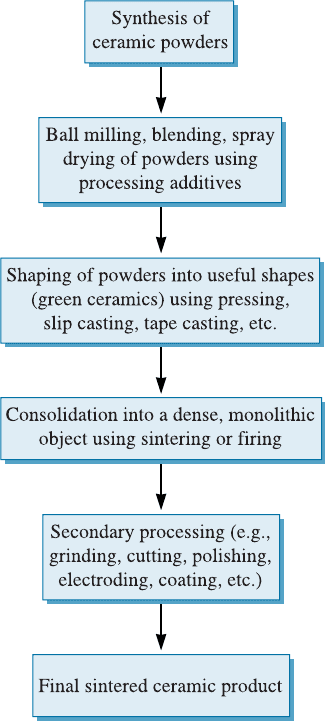
Compaction and Sintering One of the most cost-e¤ective ways to produce thousands
of relatively small pieces (@< 15 cm) of simple shapes is compaction and sintering.
Many electronic and magnetic ceramics, WC-Co (cermet) cutting tool bits, and other
materials are processed using this technique. The driving force for sintering is the re-
duction in the surface area of a powder (Chapter 5). Fine powders can be spray dried,
forming soft agglomerates that flow and compact well. The di¤erent steps of uniaxial
compaction, in which the compacting force is applied in one direction, are shown in
Figure 15-3(a) on page 475. As an example, the microstructure of a barium magnesium
tantalate ceramic prepared using compaction and sintering is shown in Figure 15-3(b).
Sintering involves di¤erent mass transport mechanisms [Figure 15-3(c)]. With sintering,
the grain boundary and bulk (volume) di¤usion contribute to densification (increase in
density). Surface di¤usion and evaporation condensation can cause grain growth, but
they do not cause densification.
The compaction process can be completed within one minute for smaller parts;
thus, uniaxial compaction is well suited for making a large number of smaller and sim-
ple shapes. Compaction is used to create what we call ‘‘green ceramics’’; these have re-
spectable strengths and can be handled and machined. In some cases, very large pieces
(up to 100 cm in diame ter and 200 cm to 240 cm long) can be produced using a process
called cold isostatic pressing (CIP) where pressure is applied using oil. Such large pieces
Figure 15-1
Typical steps encountered in the processing of
ceramics.
15-3 Synthesis and Processing of Ceramic Powders 473
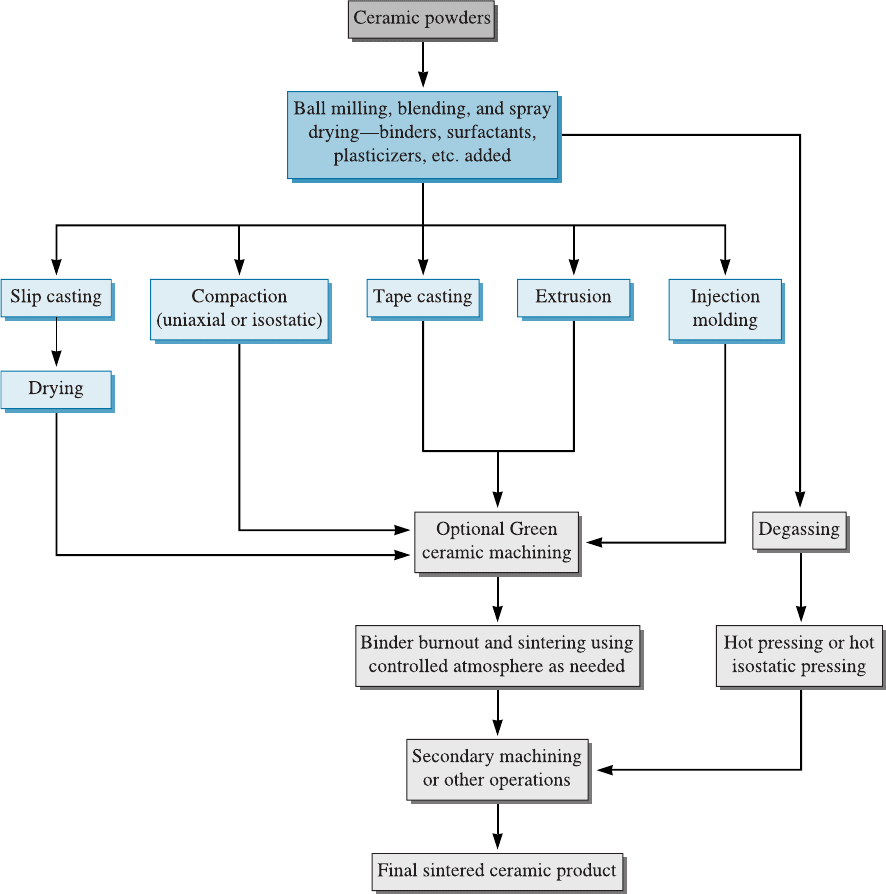
are then sintered with or without pressure. Cold isostatic pressing is used for achieving
a higher green ceramic density or where the compaction of more complex shapes is
required.
In some cases, parts may be produced under conditions in which sintering is
conducted using applied pressure. This technique, known as hot pressing, is used for
refractory and covalently bonded ceramics that do not show good pressureless sintering
behavior. Similarly, large pieces of metals and alloys compacted using CIP can be sin-
tered under pressure in a process known as hot isostatic pressing (HIP). In hot pressing
or HIP, the applied pressure acts against the internal pore pressure and enhances den-
sification without causing grain growth. Hot pressing or hot isostatic pressing also are
Figure 15-2 Different techniques for processing of advanced ceramics.
CHAPTER 15 Ceramic Materials474
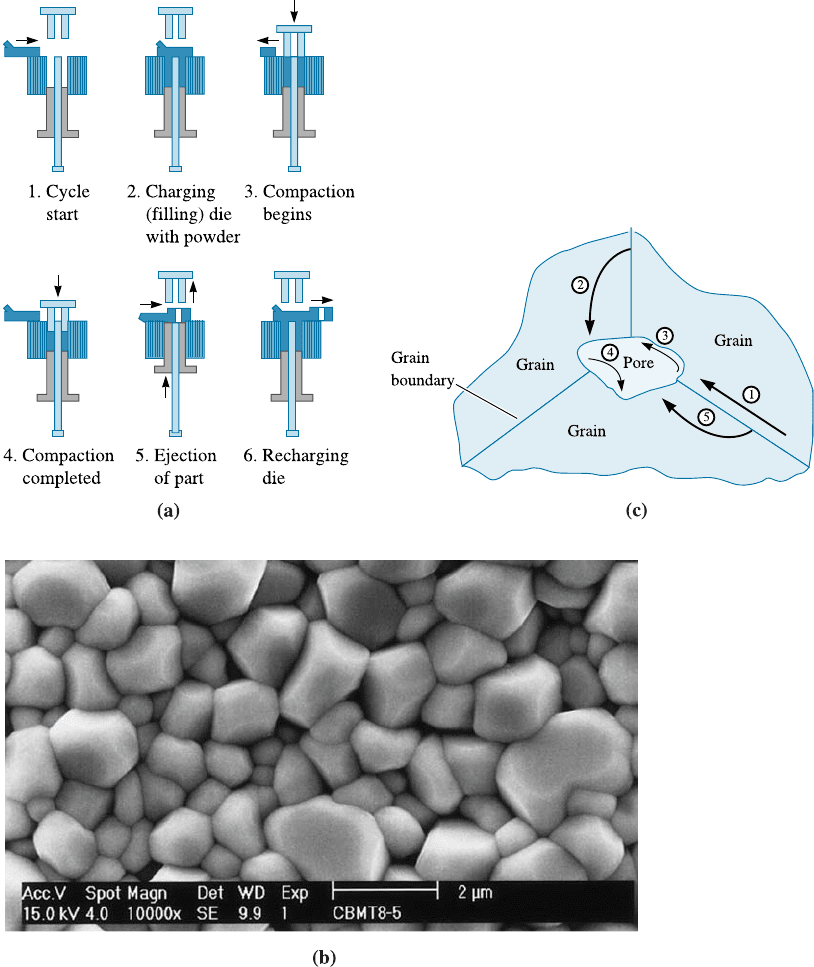
Figure 15-3 (a) Uniaxial powder compaction showing the die-punch assembly during different
stages. Typically, for small parts these stages are completed in less than a minute.
(Source: From Materials and Processes in Manufacturing, Eighth Edition, by E.P. DeGarmo,
J.T. Black, and R.A. Koshe, Fig. 16-4. Copyright > 1997 Prentice Hall. Reprinted with
permission from John Wiley & Sons, Inc.) (b) Microstructure of a barium magnesium tantalate
(BMT) ceramic prepared using compaction and sintering. (Photo Courtesy Schott North
America.) (c) Different diffusion mechanisms involved in sintering. The grain boundary and
bulk diffusion (1, 2 and 5) to the neck contribute to densification. Evaporation-condensation
(4) and surface diffusion (3) do not contribute to densification. (Source: From Physical
Ceramics: Principles for Ceramic Science and Engineering, by Y.M. Chiang, D. Birnie, and
W.D. Kingery, Fig. 5-40. Copyright 1997 John Wiley & Sons, Inc. This material is used by John
Wiley & Sons, Inc.)
15-3 Synthesis and Processing of Ceramic Powders 475

used for making ceramics or metallic alloys where very little or almost no porosity is
required. Some recent innovative processes that make use of microwaves (similar to the
way food gets heated in microwave oven) have also been developed for the drying and
sintering of ceramic materials.
Some ceramics, such as silicon nitride (Si
3
N
4
), are produced by reaction bonding.
Silicon is formed into a desired shape and then reacted with nitrogen to form the
nitride. Reaction bonding, which can be done at lower temperatures, provides better
dimensional control compared with hot pressing; however, lower densities and me-
chanical properties are obtained. As a comparison, the e¤ect of processing on silicon
nitride ceramics is shown in Table 15-4.
Tape Casting A technique known as tape casting is used for the production of thin
ceramic tapes (@3 to 100 mm). The tape is subjected to sintering. Many commercially
important electronic packages based on alumina substrates and millions of barium ti-
tanate capacitors are made using this type of tape casting process.
Slip Casting This technique typically uses an aqueous slurry of ceramic powder. The
slurry, known as the slip, is poured into a plaster of Paris (CaSO
4
:2H
2
O) mold (Figure
15-4). As the water from the slurry begins to move out by capillary action, a thick mass
builds along the mold wall. When su‰cient product thickness is built, the rest of the
slurry is poure d out (this is called drain casting). It is also possible to continue to pour
more slurry in to form a solid piece (this is called solid casting) (Figure 15-4). Pressure
may also be used to inject the slurry into polymer molds. The green ceramic is then
dried and ‘‘fired’’ or sintered at a high temperature. Slip casting is widely used to make
ceramic art (figurines and statues), sinks and other ceramic sanitaryware.
Extrusion and Injection Molding These are popular techniques used for making fur-
nace tubes, bricks, tiles, and insulators. The idea behind the extrusion process is to use
a viscous, dough-like mixture of ceramic particles containing a binder and other addi-
tives. This mixture has a clay-like consistency, which is then fed to an extruder where
it is mixed well in a pug mill, sheared, deaerated, and then injected into a die where a
continuous shape of green ceramic is produced by the extruder. This material is cut at
appropriate lengths and then dried and sintered. Cordierite ceramics used for making
catalyst honeycomb structures are also made using the extrusion process.
Injection molding of ceramics is similar to injection molding of polymers (Chapter
16). Ceramic powder is mixed with a thermoplastic plasticizer and other additives. The
mixture is then taken through an extruder and injected into a die. Ceramic injection
molding is better suited for complex shapes. The polymer contained in the injection-
molded ceramic is burnt o¤ and the rest of the ceramic body is sintered at a high tem-
perature. This technique is especially useful for manufacturing complex shapes.
TABLE 15-4 9 Properties of Si
3
N
4
processed using different
techniques
Process
Compressive
Strength (MPa)
Flexural
Strength (MPa)
Slip casting 138 69
Reaction bonding 772 207
Hot pressing 345 862
CHAPTER 15 Ceramic Materials476
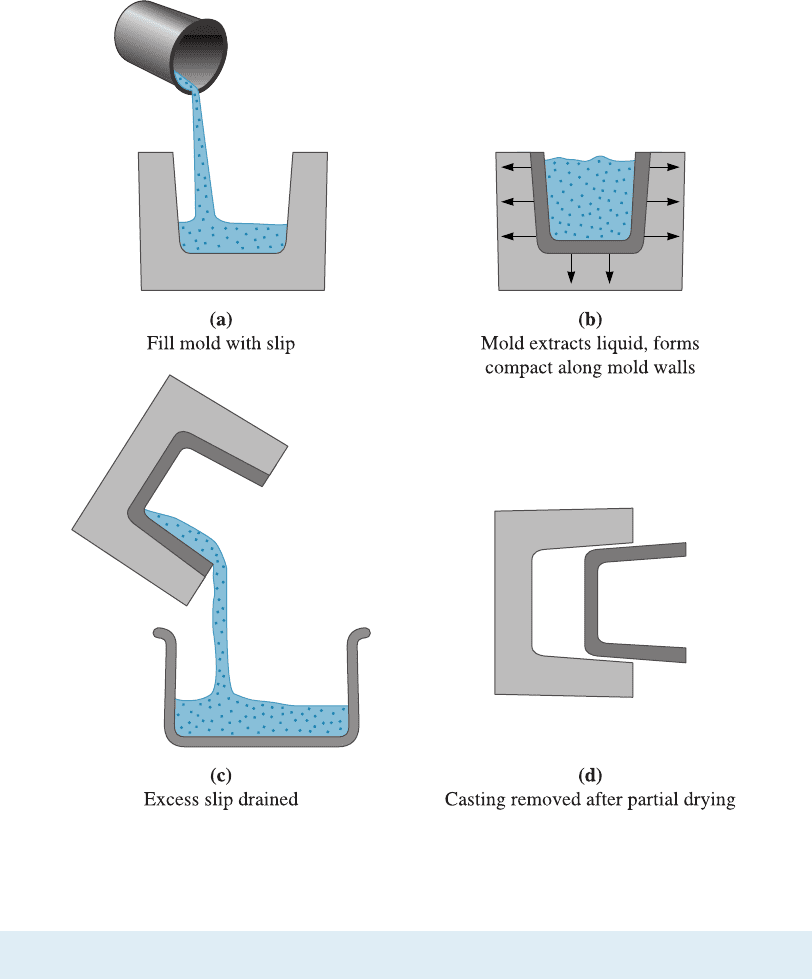
15-4 Characteristics of Sintered Ceramics
For sintered ceramics, the average grain size, grain size distribution, and the level and
type of porosity are important. Similarly, depending upon the application, second
phases in the microstructure could occur as separate grains of components dissolved in
solid solut ions of the matrix. Therefore, second phases at grain boundaries also become
important. In the case of extruded ceramics, orientation e¤ects also can be important.
Grains and Grain Boundaries The average grain size is often closely related to the
primary particle size. An exception to this is if there is grain growth due to long sinter-
ing times or exaggerated or abnormal grain growth (Chapter 5). Typically, ceramics
Figure 15-4 Steps in slip casting of ceramics. (Source: From Modern Ceramic Engineering,by
D.W. Richerson, p. 462, Fig. 10-34. Copyright > 1992 Marcel Dekker. Reprinted by
permission.)
15-4 Characteristics of Sintered Ceramics 477

with a small grain size are stronger than coarse-grained ceramics. Finer grain sizes help
reduce stresses that develop at grain boundaries due to anisotropic expansion and con-
traction. Normally, starting with fine ceramic raw materials produces a fine grain size.
Magnetic, dielectric, and optical properties of ceramic materials depend upon the aver-
age grain size and, in these applications, grain size must be controlled properly. Al-
though we have not discussed this here in detail, in certain applications, it is important
to use single crystals of ceramic materials so as to avoid the deleterious grain bound-
aries that are always present in polycrystalline ceramics.
Porosity Pores represent the most important defect in polycrystalline ceramics. The
presence of pores is usually detrimental to the mechanical prope rties of bulk ceramics,
since pores provide a pre-existing location from which a crack can grow. The presence
of pores is one of the reasons why ceramics show such brittle behavior under tensile
loading. Since there is a distribution of pore sizes and the overall level of porosity
changes, the mechanical properties of ceramics vary. This variability is measured using
the Weibull statistics (Chapt er 7). The presence of pores, on the other hand, may be
useful for increasing the resistance to thermal shock. In certain applications, such as
filters for hot metals and alloys or for liquids or gases, the presence of interconnected
pores is desirable.
Pores in a ceramic may be either interconnected or closed. The apparent porosity
measures the interconnected pores and determines the permeability, or the ease with
which gases and fluids seep through the ceramic component. The apparent porosity is
determined by weighing the dry ceramic (W
d
), then reweighing the ceramic both when
it is suspended in water (W
s
) and after it is removed from the water (W
w
). Using units
of grams and cm
3
:
Apparent porosity ¼
W
w
W
d
W
w
W
s
100 ð15-1Þ
The true porosity includes both interconnected and closed pores. The true porosity,
which better correlates with the properties of the ceramic, is:
True porosity ¼
r B
r
100 ð15-2Þ
where
B ¼
W
d
W
w
W
s
ð15-3Þ
B is the bulk density and r is the true density or specific gravity of the ceramic. The bulk
density is the weight of the ceramic divided by its volume. The following example il-
lustrates how porosity levels in ceramics are determined.
EXAMPLE 15-1
Silicon Carbide Ceramics
Silicon carbide particles are compacted and fired at a high temperature to pro-
duce a strong ceramic shape. The specific gravity of SiC is 3.2 g/cm
3
. The
ceramic shape subsequently is weighed when dry (360 g), after soaking in water
(385 g), and while suspended in water (224 g). Calculate the apparent porosity,
the true porosity, and the fraction of the pore volume that is closed.
CHAPTER 15 Ceramic Materials478
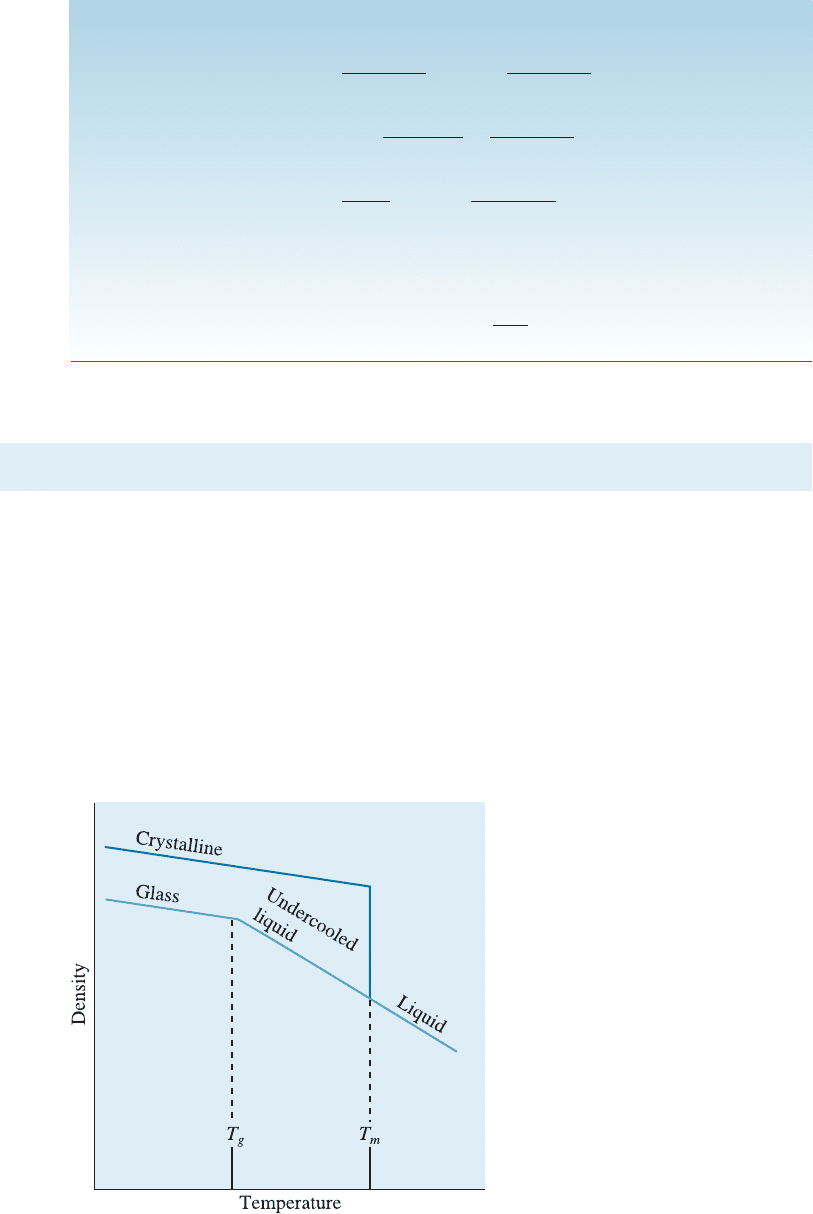
SOLUTION
Apparent porosity ¼
W
w
W
d
W
w
W
s
100 ¼
385 360
385 224
100 ¼ 15:5%
Bulk density ¼ B ¼
W
d
W
w
W
s
¼
360
385 224
¼ 2:24
True porosity ¼
r B
r
100 ¼
3:2 2:24
3:2
100 ¼ 30%
The closed-pore percentage is the true porosity minus the apparent porosity, or
30 15:5 ¼ 14:5%. Thus,
Fraction closed pores ¼
14:5
30
¼ 0:483
15-5 Inorganic Glasses
In Chapter 3, we discussed amorphous materials such as glasses. We also discussed the
concepts of short- versus long-range order in terms of atomic or ionic arrangements in
noncrystalline materials. The most important of the noncrystalline materials are glasses,
especially those based on silica. Of course, there are glasses based on other compounds
(e.g., sulfides, fluorides, and di¤erent alloys). A glass is a metastable material that has
hardened and become rigid without crystallizing. A glass, in some ways, resembles an
undercooled liquid. Below the glass temperature (T
g
) (Figure 15-5), the rate of volume
contraction on cooling is reduced and the material can be considered a ‘‘glass’’ rather
than an ‘‘undercooled liquid.’’ Joining silica tetrahedra or other ionic groups produces a
solid, but noncrystalline framework structure produces the glassy structures (Chapter 3).
Figure 15-5
When silica crystallizes on cooling,
an abrupt change in the density is
observed. For silica glass, however,
the change in slope at the glass
temperature indicates the formation of
a glass from the undercooled liquid.
Glass does not have a fixed T
m
or T
g
.
Crystalline materials have a fixed T
m
and they do not have a T
g
.
15-5 In organic Glasses 479
